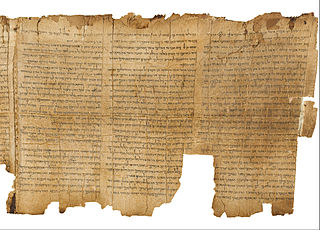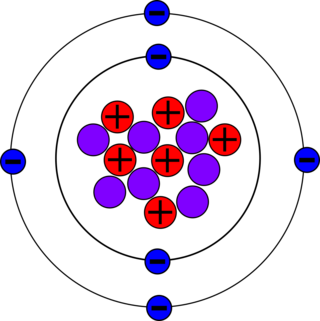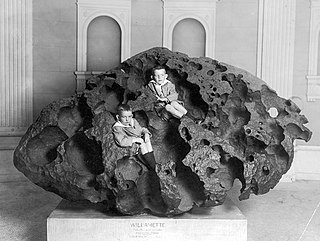Related Research Articles

Radiocarbon dating is a method for determining the age of an object containing organic material by using the properties of radiocarbon, a radioactive isotope of carbon.

A Martian meteorite is a rock that formed on Mars, was ejected from the planet by an impact event, and traversed interplanetary space before landing on Earth as a meteorite. As of September 2020, 277 meteorites had been classified as Martian, less than half a percent of the 72,000 meteorites that have been classified. The largest complete, uncut Martian meteorite, Taoudenni 002, was recovered in Mali in early 2021. It weighs 14.5 kilograms and is on display at the Maine Mineral & Gem Museum.

Carbon-14, C-14, 14
C or radiocarbon, is a radioactive isotope of carbon with an atomic nucleus containing 6 protons and 8 neutrons. Its presence in organic materials is the basis of the radiocarbon dating method pioneered by Willard Libby and colleagues (1949) to date archaeological, geological and hydrogeological samples. Carbon-14 was discovered on February 27, 1940, by Martin Kamen and Sam Ruben at the University of California Radiation Laboratory in Berkeley, California. Its existence had been suggested by Franz Kurie in 1934.

Geochronology is the science of determining the age of rocks, fossils, and sediments using signatures inherent in the rocks themselves. Absolute geochronology can be accomplished through radioactive isotopes, whereas relative geochronology is provided by tools such as paleomagnetism and stable isotope ratios. By combining multiple geochronological indicators the precision of the recovered age can be improved.
The Research Laboratory for Archaeology and the History of Art (RLAHA) is a laboratory at the University of Oxford, England which develops and applies scientific methods to the study of the past. It was established in 1955 and its first director was Teddy Hall. The first deputy director was Dr Stuart Young, who was followed by Martin Aitken in 1957. After many years of de facto association with the Institute of Archaeology, in 2000 it was jointly brought under the single departmental umbrella of School of Archaeology.
The Shroud of Turin, also known as the Holy Shroud, is a length of linen cloth that bears a faint image of the front and back of a man. It has been venerated for centuries, especially by members of the Catholic Church, as the actual burial shroud used to wrap the body of Jesus of Nazareth after his crucifixion, and upon which Jesus's bodily image is miraculously imprinted. The human image on the shroud can be discerned more clearly in a black and white photographic negative than in its natural sepia color, an effect discovered in 1898 by Secondo Pia, who produced the first photographs of the shroud. This negative image is associated with a popular Catholic devotion to the Holy Face of Jesus. The shroud's authenticity as a holy relic has been disputed even within the Catholic Church, and radiocarbon dating has shown it to be a medieval artifact.

Accelerator mass spectrometry (AMS) is a form of mass spectrometry that accelerates ions to extraordinarily high kinetic energies before mass analysis. The special strength of AMS among the mass spectrometric methods is its power to separate a rare isotope from an abundant neighboring mass. The method suppresses molecular isobars completely and in many cases can separate atomic isobars also. This makes possible the detection of naturally occurring, long-lived radio-isotopes such as 10Be, 36Cl, 26Al and 14C. Their typical isotopic abundance ranges from 10−12 to 10−18. AMS can outperform the competing technique of decay counting for all isotopes where the half-life is long enough. Other advantages of AMS include its short measuring time as well as its ability to detect atoms in extremely small samples.
Aluminium or aluminum (13Al) has 22 known isotopes from 22Al to 43Al and 4 known isomers. Only 27Al (stable isotope) and 26Al (radioactive isotope, t1/2 = 7.2×105 y) occur naturally, however 27Al comprises nearly all natural aluminium. Other than 26Al, all radioisotopes have half-lives under 7 minutes, most under a second. The standard atomic weight is 26.9815385(7). 26Al is produced from argon in the atmosphere by spallation caused by cosmic-ray protons. Aluminium isotopes have found practical application in dating marine sediments, manganese nodules, glacial ice, quartz in rock exposures, and meteorites. The ratio of 26Al to 10Be has been used to study the role of sediment transport, deposition, and storage, as well as burial times, and erosion, on 105 to 106 year time scales. 26Al has also played a significant role in the study of meteorites.

Edward Thomas Hall, CBE, Hon. FBA, FSA, also known as Teddy Hall, was a British scientist and balloonist who is best remembered for exposing the Piltdown Man as a fraud.

Mullerornis modestus is an extinct species of elephant bird, and the only member of the genus Mullerornis.

The Shroud of Turin, a linen cloth that tradition associates with the crucifixion and burial of Jesus, has undergone numerous scientific tests, the most notable of which is radiocarbon dating, in an attempt to determine the relic's authenticity. In 1988, scientists at three separate laboratories dated samples from the Shroud to a range of 1260–1390 AD, which coincides with the first certain appearance of the shroud in the 1350s and is much later than the burial of Jesus in 30 or 33 AD. Aspects of the 1988 test continue to be debated. Despite some technical concerns that have been raised about radiocarbon dating of the Shroud, no radiocarbon-dating expert has asserted that the dating is unreliable.
Surface exposure dating is a collection of geochronological techniques for estimating the length of time that a rock has been exposed at or near Earth's surface. Surface exposure dating is used to date glacial advances and retreats, erosion history, lava flows, meteorite impacts, rock slides, fault scarps, cave development, and other geological events. It is most useful for rocks which have been exposed for between 103 and 106 years.
Arizona Accelerator Mass Spectrometry Laboratory focuses on the study of cosmogenic isotopes, and in particular the study of radiocarbon, or Carbon-14. As a laboratory, part of its aim is to function as a research center, training center, and general community resource. Its stated mission is conducting original research in cosmogenic isotopes. The AMS laboratory was established in 1981 at the University of Arizona.

Meteorite weathering is the terrestrial alteration of a meteorite. Most meteorites date from the oldest times in the Solar System and are by far the oldest material available on our planet. Despite their age, they are vulnerable to the terrestrial environment. Water, chlorine and oxygen attack meteorites as soon as they reach the ground.

The Tissint meteorite is a Martian meteorite that fell in Tata Province in the Guelmim-Es Semara region of Morocco on July 18, 2011. Tissint is the fifth Martian meteorite that people have witnessed falling to Earth, and the first since 1962. Pieces of the meteorite are on display at several museums, including the Museum of Natural History of Vienna and the Natural History Museum in London.

The 774–775 carbon-14 spike is an observed increase of around 1.2% in the concentration of the radioactive carbon-14 isotope in tree rings dated to 774 or 775 CE, which is about 20 times higher than the normal year-to-year variation of radiocarbon in the atmosphere. It was discovered during a study of Japanese cedar tree-rings, with the year of occurrence determined through dendrochronology. A surge in beryllium isotope 10
Be, detected in Antarctic ice cores, has also been associated with the 774–775 event. The 774–775 CE carbon-14 spike is one of the several Miyake events and it produced the largest and most rapid rise in carbon-14 ever recorded.

Northwest Africa 7034 is a Martian meteorite believed to be the second oldest yet discovered. It is estimated to be two billion years old and contains the most water of any Martian meteorite found on Earth. Although it is from Mars it does not fit into any of the three SNC meteorite categories, and forms a new Martian meteorite group named "Martian ". Nicknamed "Black Beauty", it was purchased in Morocco and a slice of it was donated to the University of New Mexico by its American owner. The image of the original NWA 7034 was photographed in 2012 by Carl Agee, University of New Mexico.

The Shroud of Turin is a length of linen cloth bearing the imprint of the image of a man, and is believed by some to be the burial shroud of Jesus. Despite conclusive scientific evidence that it is of medieval origin, multiple alternative theories about the origin of the shroud dating it to the time of Christ have been proposed.

Modern archaeology is the discipline of archaeology which contributes to excavations.
Weijian Zhou is a geologist at the Chinese Academy of Sciences known for her research into environmental changes in the Quaternary era using radiocarbon data.
References
- ↑ "A.J. Timothy Jull". University of Arizona. Archived from the original on 2012-01-31.
- ↑ "Radiocarbon: An International Journal of Cosmogenic Isotope Research". Archived from the original on 2007-05-31. Retrieved 2012-05-25.
- ↑ "UA Team Verifies Age of Gospel of Judas". Tucson Citizen. Apr 7, 2006.
- ↑ "Radiocarbon Dating of the Shroud of Turin". Reprinted from Nature, Vol. 337, No. 6208, pp. 611-615, 16th February, 1989.
- ↑ "Carbon From Martian Meteorites Not Evidence of Life". UANews. May 24, 2012. Archived from the original on July 24, 2012.
{{cite web}}: CS1 maint: unfit URL (link) - ↑ "Curriculum Vitae" (PDF).